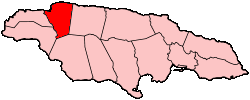
Population: 178,000 (1999)
Capital: Montego Bay
Major Towns: Adelphi, Cambridge, Montpelier, Catadupa, Fairfield

Situated in the north-western section of Jamaica, St. James covers an area of 595 square kilometers. The parish is defined by its rugged limestone terrain and the majestic Nassau Mountains that extend from St. Elizabeth in the south and taper off just south of Montego Bay. Its natural features are further accentuated by two major rivers—the Great River forming part of the Hanover boundary, and the Montego River, which flows northward from central St. James into Montego Bay.
During Spanish rule, the area now known as Montego Bay was nicknamed "Manteca Bahia" (Lard Bay) because of its production of hog’s lard. Renamed in honor of King James II by Sir Thomas Modyford, Jamaica's first English Governor, St. James was once among the poorest parishes. However, the advent of the sugar industry after 1739 transformed the region. By 1782, Montego Bay had emerged as a vital economic hub, second only to Kingston, with a bustling trade that saw over 150 ships arriving each year.
The parish also played a crucial role during the Christmas Rebellion of 1831–1832, led by the National Hero Sam Sharpe. Additionally, early tourism in Jamaica was spurred by the famed curative properties of Doctors Cave beach.
Tourism: Montego Bay has grown into Jamaica’s premier tourist destination, with tourism employing one in four residents. With over 500,000 annual visitors, the sector accounts for roughly one-third of Jamaica's tourism revenue. Prestigious hotels, including the Ritz Carlton, underscore the region's global appeal.
Agriculture: Key agricultural activities include forestry, sugar cane cultivation, and a variety of domestic crops.
Manufacturing: St. James hosts around 60 manufacturing establishments focusing on garments, woodwork, and food processing, with industrial zones such as the Montego Free Zone and Bogue Industrial Estate bolstering the local economy.
The Dome: Constructed in 1837 at the junction of Creek and Dome Streets, this six-sided brick edifice once protected Montego Bay’s sole reliable water supply.
Rocklands Bird Feeding Sanctuary: Founded by naturalist Lisa Salmon, this sanctuary hosts an impressive array of bird species, including 24 endemic varieties, and serves as a vital stopover along the main migration route between North and South America.
St. James Parish Church: Built between 1775 and 1882 in the shape of a Greek cross, this church houses exquisite monuments—including works by John Bacon—and a memorial to Rose Palmer, linked to the legend of the White Witch of Rose Hall.
Sam Sharpe Square: This commemorative square, named after National Hero Sam Sharpe, features a statue unveiled in 1983 marking Jamaica’s 21st year of independence.
Rose Hall Great House: Steeped in legend, this 1770 mansion—restored in 1966—draws over 100,000 visitors each year, enthralled by the tale of the White Witch, Annie Palmer.
The Cage: A modest cut-stone structure built in 1806, originally used as a lockup for vagrants, disorderly seamen, and runaway slaves.
Old Slave Ring - Cotton Tree Lodge: Located on the grounds of Rerrie’s house in Montego Bay, this semi-circular arena was historically used to display slaves to potential buyers.
Additional attractions include Barnett Estate, Blue Hole Garden, Burchell Memorial Church (the resting place of Sam Sharpe), Greenwood Great House, and The Town House at 16 Church Street.